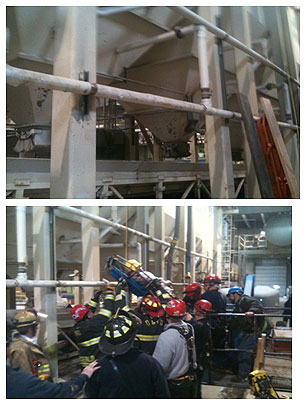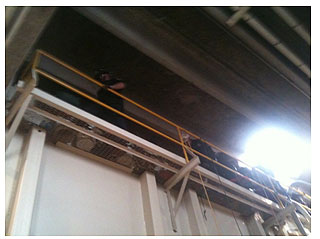By Chuck Wehrli
After years of training, certifying, and working with our mutual-aid members, it all came together.
A worker in a local Naperville, Illinois, concrete plant entered a sand hopper and became trapped, reportedly up to his neck. Coworkers threw in some boards to stand on and started removing sand from around him after the victim finally made contact with them. Nearly an hour later, they finally called 911.
Our department has a technical rescue team trained to the technician level in almost all rescue disciplines and supported by a semitruck and trailer with an extensive inventory. The call went out at a box level and was then upgraded to a second alarm, pulling in our mutual- aid box alarm system (MABAS) division, including crews from Lisle Woodridge, Downers Grove, and Bolingbrook.
Our initial response plan on a call like this or any trench accident includes calling our public works department for its vacuum trucks. The department responded with five employees and two of the vacuum trucks. We had trained with public works during our trench classes previously using the vac trucks. Approximately 10 other fire departments also responded as the alarm level was raised.
The sand hopper was one of several in a line used to make concrete panels for buildings. There was a catwalk 30 feet up that the employees could use to access the hoppers for maintenance. They use a 10-foot scraper to clean off the sides; they are not allowed to enter, as this is a permit-required confined space because of the engulfment potential.

The Rescue Vac System. (Photo by Chief Lyne)
First-in responders assessed the situation and followed the department’s standard operating guidelines (SOGs) for the technical rescue situation. A call was sent out for the rescue vac system developed by local Addison Fire Department Lieutenant Dave Adler. It was used in 10 saves across the country at trench and grain bin rescue incidents. Once the rescue vac kit arrived, responders worked with public works employees and set up a vac truck at the closest overhead door. They then deployed the vac kit with 40 feet of eight-inch hose to the safety tee and then reduced it to 50 feet of the four-inch hose with the specially designed tip. It was raised up to the catwalk and then activated to start removing the sand around the victim.
A chest harness was already placed on the victim so he could not sink in the sand. Rescuers put a full harness on him so some material could be removed by opening the lower hopper door. All emergency medical services protocols were followed, including 12 leads, warm intravenous lines, O2, and notification to the hospital about possible crush syndrome.

As the victim and situation stabilized, the plant owners and engineers stood by to offer any information they had. A lift was used to lower the victim from the 30-foot-high catwalk. A haul system was set up on the catwalk to pull the victim out of the hopper.
The Liberty Rescue Tube that was deployed is designed so that first responders can use this device to prevent fatalities that result from victims being trapped in flowing grain. Four vertical interlocking units that form a cylinder are driven section by section into the grain surrounding the entrapped victim, allowing the grain to be removed so the victim can be safely extricated. It came with the Rescue Vac system from our mutual-aid departments.

After about three hours of stabilizing the patient and removing enough sand to place a full harness on him and get him boarded, he was hauled out of the hopper to the catwalk, placed in the lift, and lowered to the floor. The rescue was a great job by all involved. The victim was released from the hospital two days later; he returned to work with no restrictions.
Being proactive, the owners decided to contact the local Occupational Safety and Health Administration (OSHA) office so a full investigation could be conducted to help ensure that this doesn’t happen again. A side story to this is that I was contacted five days before this happened to do an annual confined-space refresher course later in the month.
Teamwork and training with all our local mutual-aid departments paid off. Calls like this are rare, but when things like this happen, it is great to see everything come together to facilitate a positive outcome.
Chuck Wehrli is a retired captain from the Naperville (IL) Fire Department. He spent 34 years with the department, including time as a technical rescue team member and coordinator. He is an adjunct instructor for the National Fire Academy, a former FEMA US&R Safety Officer, a member of the National Fire Protection Association (NFPA) 1006 committee on technical rescue qualifications, and has contributed to numerous fire service periodicals. He can be reached at fireL7@aol.com.
RELATED


